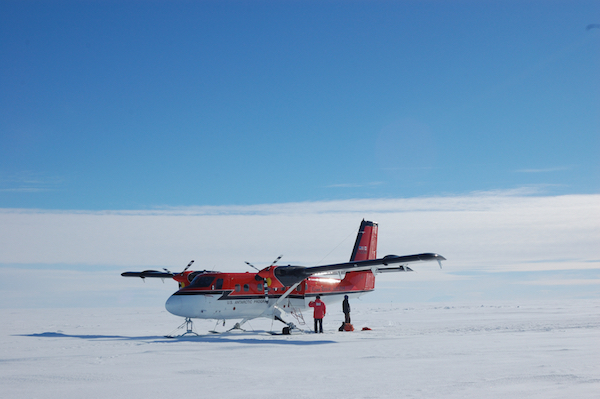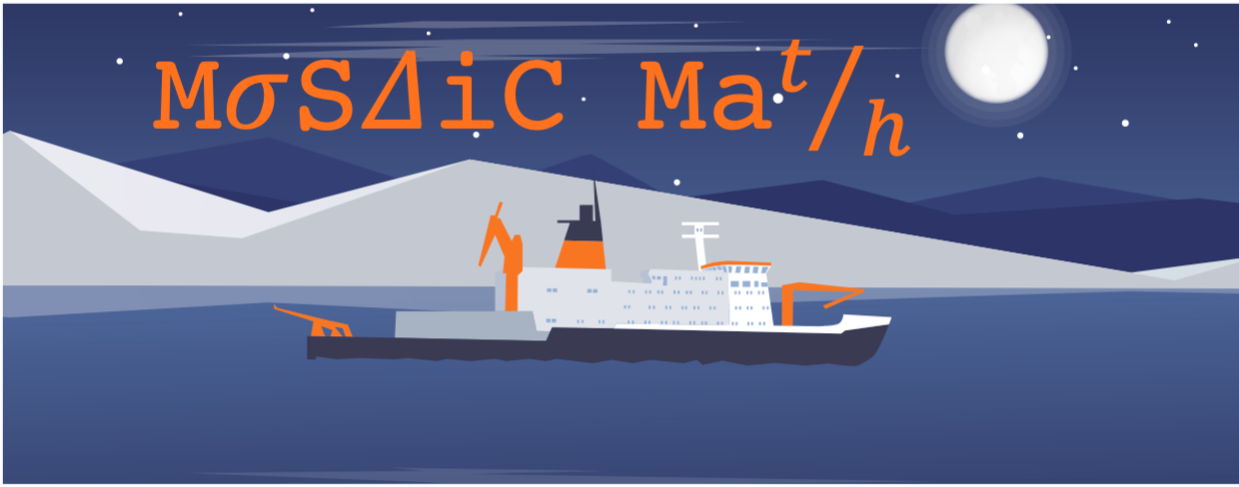Solutions to MOSAiC Math Problems
Race to the North
On February 24th, the Polarstern was 97 miles (156 km) from the North Pole. If you jumped on a snowmobile and headed out from the Polarstern straight towards the North Pole going 35 miles/hour, how long would it take you to get there? How much time would you save if you traveled at 55 miles/hour?
SOLUTION:
Time to get to the North Pole = Distance to North Pole / Speed of snowmobile
Time to get to the North Pole = 97 miles / (35 miles/hour) = about 2.8 hours
or
Time to get to the North Pole = 97 miles / (55 miles/hour) = about 1.8 hours
Cracks in the Ice
On March 9th, MOSAiC participants reported that a large crack, or lead, in the ice opened up about a mile from the Polarstern. The lead was about 3 miles (~5 km) long and about 545 yards (~500 m) wide. How much of the ocean's surface area was exposed by the opening of this lead? Remember that there are 1,760 yards in 1 mile.
SOLUTION:
Assuming the crack is a rectangular shape, we can use the equation for the area of a rectangle to solve this problem:
Area of a rectangle = length x width = 3 miles x (545 yards x (1 mile/1760 yards)) = about 0.9 square miles
Spuds on a Ship
It was reported that MOSAiC Leg II participants ate nearly 3,000 lbs (~1,360 kg) of potatoes! If an average potato weighs ~0.5 lbs, how many potatoes did Leg II participants eat?
SOLUTION:
Number of potatoes = Total weight of potatoes consumed / weight of a single potato
Number of potatoes = 3,000 lbs / 0.5 lbs/potato = 6,000 potatoes!!!
On Thin (or Thick) Ice
How thick must sea ice be to support a small airplane?

h=√(P/A) is a basic formula (sometimes called 'Gold's Formula') that can be used to calculate the ice thickness (h) that is needed to support a specific load (P), or weight of something. A in this equation is a constant that is related to assumptions about the nature of the ice (is it very cold and hard, is it thawing and weak, or is it somewhere in between)? We recommend using a value of 50 psi (pounds per square inch) for A, which is a conservative value for thawing (and thus the least strong) ice.
First, make a guess as to what you think the minimum thickness the sea ice underneath the runway must be to support the plane.
Then, calculate the actual minimum thickness the sea ice underneath the runway must be, assuming that the MOSAiC team wants it to be able to support a Twin Otter plane that weighs ~8,000 lbs. Does the answer surprise you? Is it similar to or different from what you guessed?
SOLUTION:
h=√(P/A) = h=√(8000 lbs/50 psi) = about 12.6 inches (about one foot)
Find out how thick the ice under the runway actually is
Analyzing the Arctic
Challenge Questions
Level I solution:
Location on Nov. 11th: 85.82 N, 116.00 E
Location on March 9th: 87.93 N, 24.20 E
Linear distance between the two locations: 525 km or about 326 miles
Level II solution:
Sea ice extent on Sept. 16th: 3.9 million km2
Sea ice extent on Nov. 25th: 10.0 million km2
10.0 million km2 - 3.9 million km2 = 6.1 million km2
BONUS challenge:
Volume (approximate) = surface area of ice x thickness of ice
Volume of sea ice on Sept. 16th with 3.64 m thickness = 3.9 million km2 x 3.64 m x (1 km / 1000 m) = 14,196 km3 of ice
Volume of sea ice on Nov. 25th with 3.64 m thickness = 10.0 million km2 x 3.64 m x (1 km / 1000 m) = 36,400 km3 of ice
36,400 km3 - 14,196 km3 = 22,204 km3 increase in ice volume between Sept. and Nov. if the ice were 3.64 m thick
Volume of sea ice on Sept. 16th with 1.89 m thickness = 3.9 million km2 x 1.89 m x (1 km / 1000 m) = 7,371 km3 of ice
Volume of sea ice on Nov. 25th with 1.89 m thickness = 10.0 million km2 x 1.89 m x (1 km / 1000 m) = 18,900 km3 of ice
18,900 km3 - 7,371 km3 = 11,529 km3 increase in ice volume between Sept. and Nov. if the ice were 1.89 m thick
Level III solution:
To calculate the average temperature, add up all temperatures for every day in the table and divide by the number of days in the table. You should get an answer of about -20.8 degrees C.
**NOTE that this doesn't actually accurately represent the average temperature participants on MOSAiC have experienced so far, as we only report temperature once a week for a very particular point in time.
Level IV solution:
There does appear to be a correlation between decreasing air temperatures and increasing sea ice extent. But we can't say much about a correlation with day length since so far most days have had zero day length (sun has not risen above the horizon).
Level V solution:
Average rate of change of sea ice growth between minimum and maximum sea ice extent = (value of sea ice maximum extent - value of sea ice minimum extent) / change in time (days)
=(14.8 million km2 - 3.9 million km2)/183 days = about 59,563 km2 per day!
